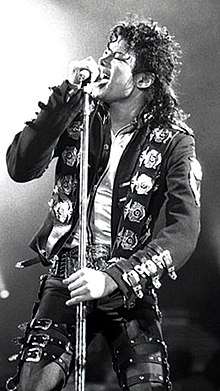Jheri curl
The Jheri curl (often spelled Jerry curl or Jeri Curl) is a permanent wave hairstyle that was popular among African Americans during the 1980s and early 1990s. Invented by the hairdresser Jheri Redding,[1] the Jheri curl gives the wearer a glossy, loosely curled look. It was touted as a "wash and wear" style that was easier to care for than the other popular chemical treatment of the day, the relaxer.

Application and maintenance
A Jheri curl requires a two-part application that consists of a softener (often called a "rearranging cream") to loosen the hair, and a solution to set the curls. The rearranging cream uses pungent chemicals, causing the naturally tight curls to loosen. The looser curls are then set and a chemical solution is then added to the hair to permanently curl it.
"Perming" is time and labor-intensive, and expensive to maintain. The chemicals required for the process often cause the wearer's natural hair to become brittle and dry.
To maintain the look of the Jheri curl, wearers are required to apply a curl activator spray and moisturizers daily, and sleep with a plastic cap over the hair to prevent it from drying out. These products are expensive; a typical bottle of activator was small, retailed from $3 to $6, and was quickly depleted. The activator in particular has the undesirable side effect of being very greasy, and often stains clothing and furniture.
Washing the hair cleanses it of the styling products and also exposes the damage done to the hair by the chemical process. As the hair grows out, the wearer is required to touch up the new hair growth, further adding to the overall expense.
To resolve the problems associated with the cost of the look, Comer Cottrell invented a cheap kit (which he called the "Curly Kit") that could be used at home, thereby enabling African-Americans to copy the style of their idols.[2]
In media

Music
Edmund Sylvers was the first African-American artist to sport the Jheri curl on an album cover, on his 1980 Casablanca release Have You Heard.[3]
The Jheri curl was worn by Michael Jackson on the cover of his blockbuster album Thriller, which was released in 1982.
Other notable wearers of the style in the 1980s and early 1990s include rappers MC Eiht, DJ Quik, Eazy-E, and Ice Cube.
Film
The 1988 comedy Coming to America features Eriq La Salle as Darryl Jenks, heir to the dynasty of a fictional product named "SoulGlo", which gave the wearer a style reminiscent of a Jheri curl while leaving the infamous greasy residue on soft furnishings.
Keenen Ivory Wayans played a character entitled "Jeri Curl" in the 1987 Robert Townsend film Hollywood Shuffle. One of Wayans' recurring characters on In Living Color, Frenchy, also sported a Jheri curl. When attending an Alcoholics Anonymous meeting and hearing others testify to how much they used to drink, Frenchy claimed he was previously "up to three and a half bottles of TCB Lite a day; I switched over to Afro Sheen, and I'm never dry!"[4]
The character Jules Winnfield (played by Samuel L. Jackson) wore a Jheri-curl in Quentin Tarantino's Pulp Fiction.
In Samuel L. Jackson's opening monologue in the 1989 film Do the Right Thing, his DJ character says that there is a "Jheri Curl alert" in effect for the day: "If you have a Jheri Curl, stay in the house or you'll end up with a permanent plastic helmet on your head forever."[5]
Sport
Los Angeles Lakers basketball player Billy Ray Bates was reported to be unpopular with other players "because he had a really moist Jheri curl, and the ball would get all slippery."[6]
Documentary
The creation and marketing of the jheri curl is featured in Bayer Mack's 2019 documentary, No Lye: An American Beauty Story, that chronicles the rise and decline of the black-owned ethnic beauty industry.[7]
See also
References
- "Milestones". Time. March 30, 1998. Archived from the original on 2009-08-12.
- Grigsby Bates, Karen (11 October 2014). "Comer Cottrell, Creator Of The People's Jheri Curl, Dies At 82". NPR. Archived from the original on 28 September 2015. Retrieved 27 September 2015.
- "Music hairstyles: a brief history of 12 iconic cuts - BBC Music". 2016-10-14. Archived from the original on 2017-02-25. Retrieved 2017-05-26.
- "Archived copy". Archived from the original on 2018-10-21. Retrieved 2018-10-08.CS1 maint: archived copy as title (link)
- "Do the Right Thing (1/10) Movie CLIP - Today's Forecast (1989) HD". YouTube. 2011-06-27. Archived from the original on 2016-07-08. Retrieved 2016-10-09.
- Jeff Pearlman. "Showtime: Magic, Kareem, Riley, and the Los Angeles Lakers Dynasty of the 1980s". Archived from the original on 2018-02-20. Retrieved 2016-06-05.
- "EXTRA! EXTRA! READ ALL ABOUT IT! 'NO LYE: AN AMERICAN BEAUTY STORY' GIVES EXCELLENT HISTORY LESSON". EURweb.com. 2019-12-03. Retrieved 2019-12-13.
External links

